National Improvement Framework for Scottish Education - 2016 Evidence Report
An overview of what we know about Scottish education and the context in which our children and young people learn.
Key Priority: Closing the attainment gap between the most and least disadvantaged children
Early years
The latest published '
Child
Health 27-30 Month Review Statistics' highlighted
inequalities: children from the most deprived
areas were more than twice as likely to have at least one
developmental concern identified (27%) than those in the least
deprived areas (12%).
Percentage with a new or previously identified concern in at least one developmental domain by deprivation quintile, 2014/15:
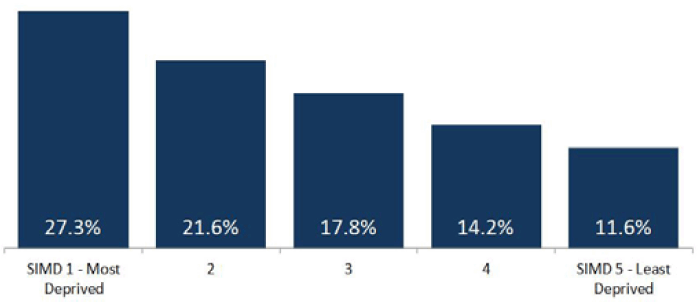
The Growing Up in Scotland report ' Language Development and Enjoyment of Reading: Impacts of Early Parent-Child Activities in Two Growing Up in Scotland cohorts' showed that:
- The difference in vocabulary between the most and least advantaged children (as measured by parental level of education) for children aged 3 in 2013 compared with children aged 3 in 2007/08 appears to have reduced slightly between the two cohorts.
Primary
Achievement in Literacy and Numeracy
The proportions of pupils in the 20% most deprived and in
the 20% least deprived areas who achieved the expected
CfE Level
relevant to their stage were:
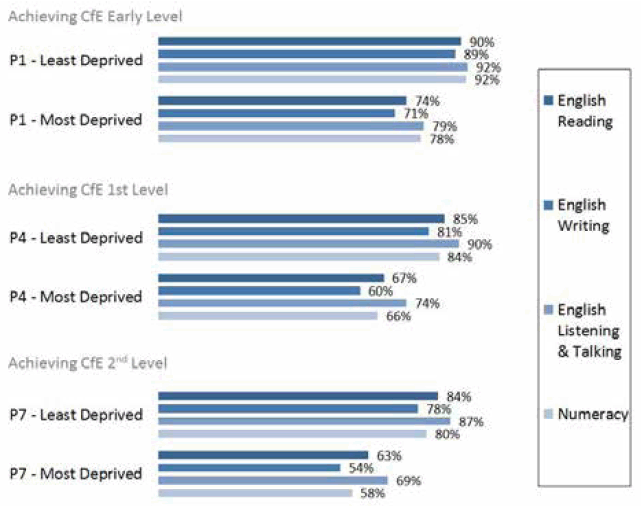
In both the SSLN 2014 (literacy) and SSLN 2015 (numeracy), pupils from the least deprived areas showed statistically significant higher performance than pupils from the most deprived areas. This was true across both primary stages measured.
The proportions of pupils in the 30% most deprived and in the 30% least deprived areas who performed well, very well or beyond their level (the 'beyond' category only exists for writing and listening and talking) were:
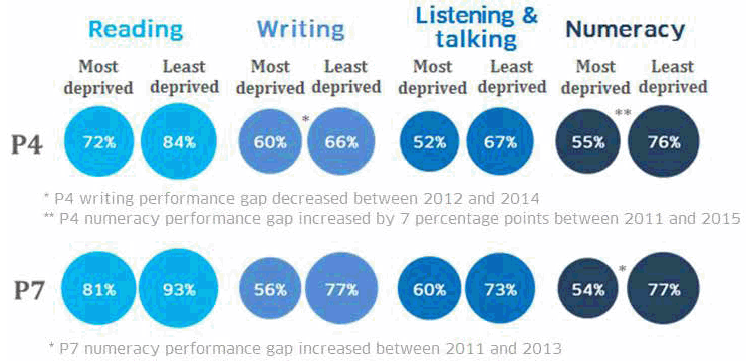
Secondary
Achievement in Literacy and Numeracy
The 2015/16 Achievement of
CfE Levels
return shows that a higher proportion of S3 pupils from the least
deprived areas achieved
CfE 3rd Level
or better compared to pupils from the most deprived areas.
The proportions of pupils in the 20% most deprived and in the 20% least deprived areas who achieved CfE 3rd Level or better were:
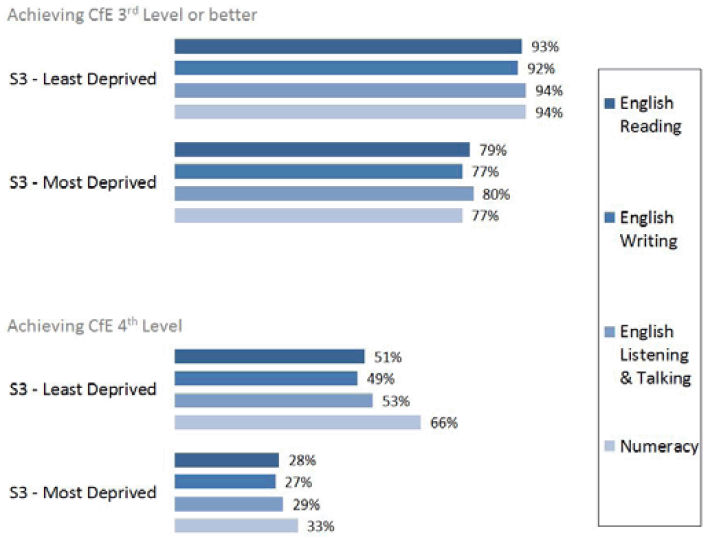
In both the SSLN 2014 (literacy) and SSLN 2015 (numeracy), S3 pupils from the least deprived areas showed statistically significant higher performance than S3 pupils from the most deprived areas.
The proportions of S3 pupils in the 30% most deprived and in the 30% least deprived areas who performed well, very well or beyond their level (the 'beyond' category only exists for writing and listening and talking) were:

Senior phase
Qualifications
Attainment at
SCQF
Level 3 or better is broadly similar between pupils in the 20%
least deprived and most deprived areas.
99.3% of school leavers from the least deprived
areas and
96.0% of leavers from the most deprived areas
gained one or more qualifications at
SCQF
Level 3 or better in 2014/2015.
The gap in attainment at SCQF level 3 or better has remained the same over the past four years at 3.3 percentage points:
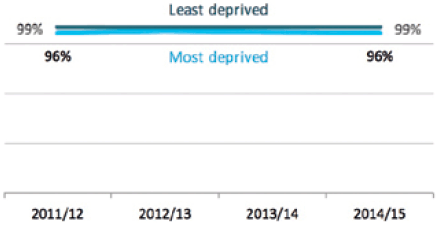
98.9% of school leavers from the 20% least deprived areas and 92.6% of leavers from the 20% most deprived areas gained one or more qualifications at SCQF Level 4 or better in 2014/2015.
The gap in attainment at SCQF level 4 or better has decreased slightly over the past four years: from 8.2 percentage points in 2011/12 to 6.4 percentage points in 2014/15
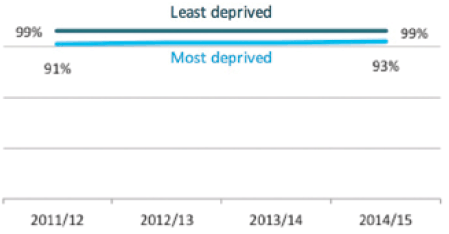
The attainment gap is wider at higher levels of qualifications: 94.9% of school leavers from the 20% least deprived areas gained one or more qualifications at SCQF Level 5 or better in 2014/15, compared with 74.0% of those from the 20% most deprived areas.
The gap in attainment at SCQF level 5 or better has decreased over the past four years: from 28.0 percentage points in 28.0 percentage points in 2011/12 to 20.9 percentage points in 2014/15:
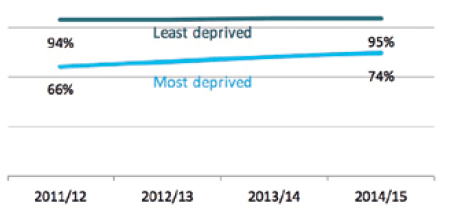
80.3% of school leavers from the 20% least deprived areas gained one or more qualifications at SCQF Level 6 or better in 2014/15, compared with 41.2% of those from the 20% most deprived areas.
This gap in attainment has decreased slightly over the pas four years:from 45.0 percentage points in 2011/12 to 39.1 percentage points in 2014/15
This gap in attainment has decreased slightly over the past four years: from 45.0 percentage points in 2011/12 to 39.1 percentage points in 2014/15:
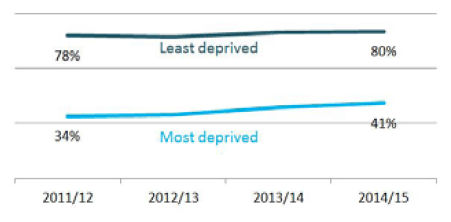
73% of looked after school leavers gained one or more qualifications at SCQF level 4 or better in 2014/15, which was an increase from 67% in 2011/12. This is substantially lower than the 96% of all school leavers who achieved this in 204/15
The difference is wider at higher levels of qualifications, 35% of looked after school leavers gained one or more qualifications at SCQF Level 5 or better in 2014/15 (an increase from 28% in 2011/12), whereas 85% of all school leavers achieved this. More information can be found in the Education Outcomes for Scotland's Looked After Children publication.
School leavers with additional support needs have lower attainment compared to school leavers with no additional support needs. For 2014/15 the percentage of school leavers by attainment at SCQF Levels 4 to 6 are shown opposite. The graph is split between pupils with additional support needs and those with no additional support needs. More information can be found in the 2016 Summary Statistics for Attainment, Leaver Destinations and Healthy Living publication.
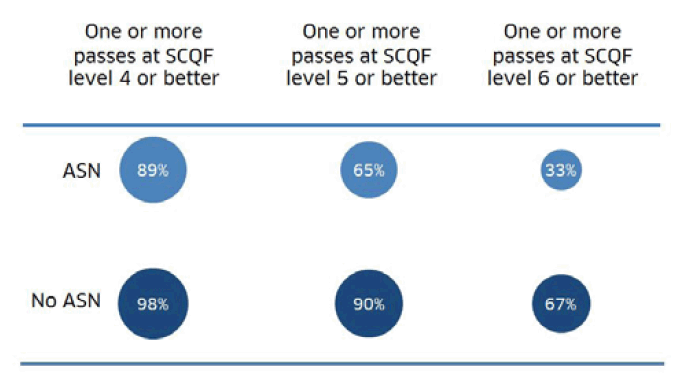
International comparisons
Differences in attainment between pupils from more
disadvantaged and less disadvantaged backgrounds exist across the
world, but in some countries the differences are larger than in
others. For example, the 2015
PISA
study showed that in France 20% of the variation in 15-year-olds'
performance in science was explained by differences in their
socio-economic background, while in Norway this was 8%.
Across OECD countries, on average 13% of the variation in 15-year-olds' performance in science in 2015 was explained by differences in their socio-economic background.
In Scotland, England and Northern Ireland the level of variation explained by socio-economic background in science was similar to the OECD average. In Wales, it was lower than the OECD average.
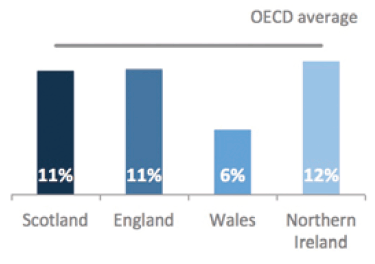
While the above figures show the share of variation in test scores that is explained by students' background, the PISA study also measures the degree to which pupils' average attainment changes as socio-economic background changes. In 2015, a one-point improvement on PISA's Index of Economic, Social and Cultural Status had an average impact across OECD countries of 37 points for maths, 37 for reading and 38 for science.
In Scotland, this difference between disadvantaged and less disadvantaged pupils was similar to the OECD average in science and maths, but lower than the OECD in reading. Between 2012 and 2015 the impact of socio-economic background was similar, but a reduction between 2009 and 2012 was maintained:
- In maths, it was 33 points in 2015 compared to 37 points in 2012 and 45 points in 2009.
- In reading, it was 32 points in 2015 compared to 35 points in 2012 and 44 points in 2009.
- In science, it was 37 points in 2015 compared to 36 points in 2012 and 47 points in 2009.
Contact
There is a problem
Thanks for your feedback